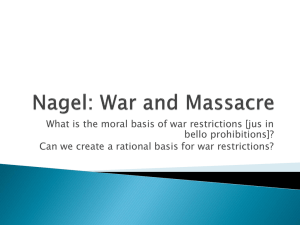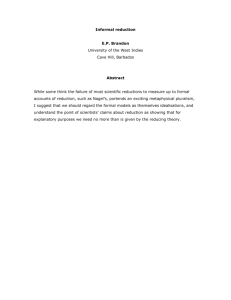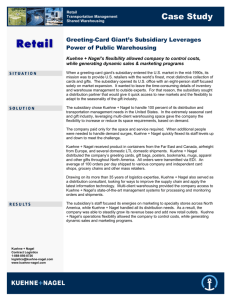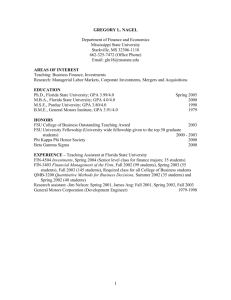160 Ethics
advertisement
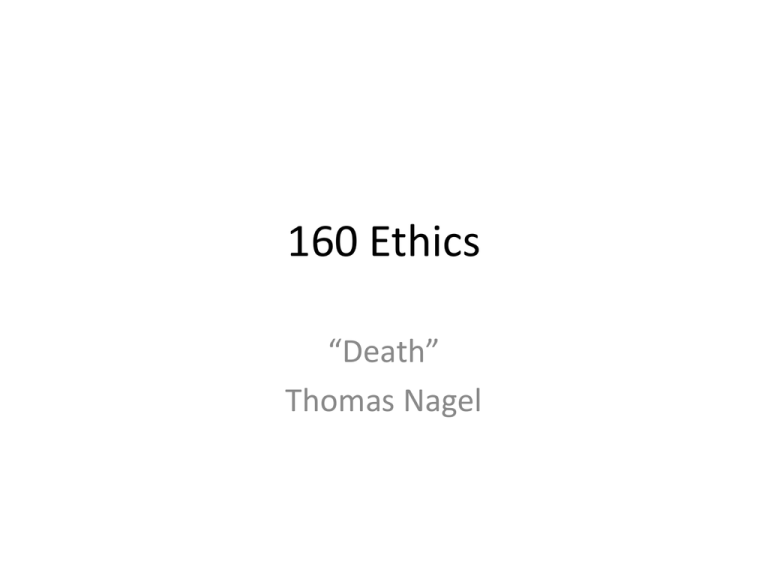
160 Ethics “Death” Thomas Nagel Death, so what? • In continuing the project of replacing moral sentiment with considered moral judgment, it is often necessary to question some or all deeply held ideas. • One of these for which Thomas Nagel supplies some substantial analysis is the idea that death, the ultimate end, is a bad thing. What is good about life? • This is a good place to start, and it seems at minimum, that experience itself, continued (though not necessarily continuous) is a good thing. If all the character of our experiences, good and bad, were stripped away, would be still value the result? What is bad about death? • Whatever is good about life, it seems clear that Bach, who lived longer than Schubert, had more of it than Schubert. • The same thing cannot be said about death. If something is bad about death, we certainly do not say that Shakespeare has had more of it than Proust. • So whatever we must say about death, there is nothing positive about it that is bad, but its badness is in that it deprives us of something good. 3 problems with regarding death as bad: 1. In order to be bad for someone, something must actually be unpleasant for them. Death does not fit this. 2. If something bad is to happen to someone, it has to happen to a given person at a given time. This is very difficult with death because when someone is dead they cease to exist so before death happens, they’re alive and not dead, and after death happens they’re dead and don’t exist any longer. 3. There is an unexplained asymmetry between disliking that we will not exist after we are dead and not minding that we did not exist before we were born. Relational versus nonrelational properties • Some properties are unitary, like the color something is, or its mass, etc. By ‘unitary’ it is meant that the property has only one subject. • A relational property necessarily has more than one subject. Properties like ‘is taller than’, ‘is better than’, etc. are relational because they require two things in order to be sensibly discussed. It would be absurd to say something like “Bob is taller” (taller than who or what?). Nagel on properties and states: • People, and the states that people are in can be positively located in definitive points in space and time (that is, you exist at all the places and times that you occupy during your lifetime). • Some goods and bads can likewise be identified with particular states (like being in pain happens at a particular time). This means being in pain is a unitary property. • Some properties may not be so spatiotemporally identified (being in an improved state of health does not happen at a given time, rather it is a comparison between your states at separate times). Being in an improved state of health is a relational property. • Some relational properties only go in one direction (e.g. ‘is taller than’) while some go in both directions (e.g. ‘is married to’). Nagel’s proposal: • “[I]t is arbitrary to restrict the goods and evils that can befall a man to nonrelational properties ascribable to him at particular times” • In other words, for something to be bad for someone, it need not have to be bad for them at any given time, or because of any particular state of the agent at any given time. The reason that death is bad then, is because it involves a relational property (being dead is worse than being alive) rather than a unitary property (being dead is bad). • This requires accepting that non-existent things may have (at least relational) properties. Some examples: • Nonexistent things have relational properties: Abraham Lincoln was taller than Louis XIV… when? • Nonexistent things have at least some unitary properties: Santa Claus wears a red suit, Charles Dickens is an author, John Wilkes Booth is a murderer. • Breaking a deathbed promise does wrong to the one who is dead… the one who does not exist. The solutions to 1 and 2: • Nagel’s answer to 1. then is to say that it is not that death is positively bad for whoever is dead, but that it is worse for them than being alive. • Nagel’s answer to 2. is that relational properties do not have to happen to people at given times, rather they are a comparison between states of a person, and persons may have properties even after they are dead. An example: • Nagel appeals to an example to deal with 1., 2., and 3. Consider an intelligent adult who suffers a brain injury and is reduced to the state of an infant, who is happy when full and comfortable. We can still say something bad has happened to them even though they themselves are not in an unhappy state after the injury (contra 1.). We can say that they have lost something that they used to have, and so the misfortune they have suffered is describable as a relational property (contra 2.). Example (continued) • To respond to 3., Nagel points out that we think the man in the example loses something (his adult faculties), and so we have a right to describe his situation as a misfortune, and it is different from his situation as an actual infant, because at that point he had not lost anything, rather he was in the process of gaining something (his adult faculties). • This describes the difference between prenatal and post mortem nonexistence. In the former we are moving from non-existence to existence, a good thing; in the latter we are moving from existence to non-existence, a bad thing. Analysis: • Is Nagel’s account convincing? That is, does it account for why we think that death is a bad thing while avoiding common objections to such thoughts? • Epicurus (who we will read later) says that death is neither to be feared nor welcomed because it is not, in itself anything at all for a person. What is Nagel’s reply to this position? • What other things do we blithely assume are good or bad, without necessarily examining why we feel that way about them?





